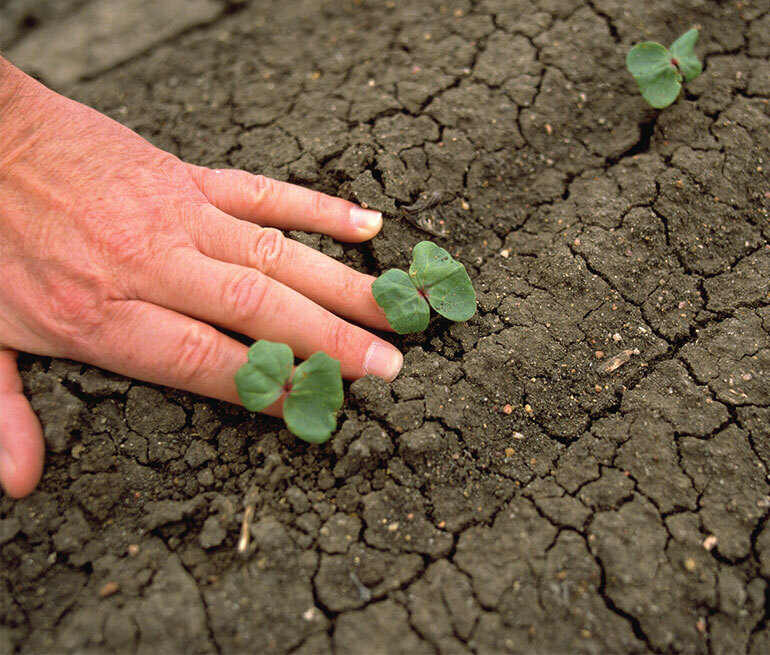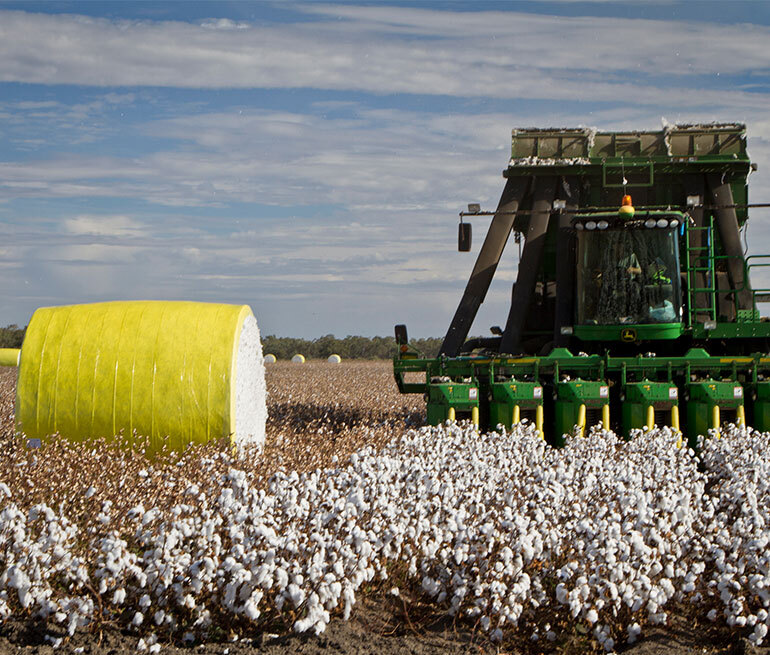How is cotton grown?
- Cotton is planted in spring, grown over summer, and picked in autumn.
- The cotton plant grows to around 1.2 metres in height.
- Each bale of cotton weighs 227 kilograms.
Cotton is a natural fibre grown on a plant related to the commonly-found garden species hibiscus.
Cotton seeds are planted in spring and the plant grows into green, bushy shrubs about one metre in height.
The plants briefly grow pink and cream coloured flowers that, once pollinated, drop off and are replaced with fruit, better known as cotton bolls.
Inside the cotton boll is fluffy, white lint as well as cotton seeds.
Once the plant has been defoliated (sprayed so the leaves die and the plant is left looking like a collection of bare sticks), and the bolls have cracked open to reveal the lint, the cotton is ready to be picked.
In Australia, cotton is picked with large mechanical harvesters and gathered into large, round, wrapped modules. The modules are then sent off to a cotton gin for processing.
During the ginning process, the lint is separated from the seeds and is then pressed into rectangular bales.
Each bale weights 227 kilograms. It is then shipped overseas to be spun, dyed, knitted and woven into fabrics like clothes and home furnishings.
The cotton-growing calendar
| Growing region | Soil preparation | Planting | Growing season | Picking (harvesting) |
| Northern Australia | November-February | January-March | February-June | June-August |
| Emerald/Dawson Valley | April-July | August-December | September-May | January-July |
| All other regions | July-September | October-November | November-March | March-June |

Farm and soil preparation
There are a number of locally-bred and adapted varieties of cotton that can be selected and grown. Varieties are generally chosen by growers based on yield, quality, disease resistance characteristics and biotechnology traits. Other traits such as season length, disease resistance and varietal determinacy also play important roles.
Fields are laser-levelled and graded, and if fields are not going to be planted with cotton again the following season, they can also be rotated either into another crop (often wheat) or fallowed.
Fields are prepared for planting, weeds are controlled, and nutrients are added if necessary. Most growers now leave their cotton stubble standing in the field and mulch it back into the soil to add valuable nutrients.
Soil moisture is also checked and pre-watering is undertaken if necessary.

Planting
Growers check the soil temperature regularly before planting. Cotton seed is planted in the spring, as soon as the soil is warm enough to be sure of satisfactory seed germination and crop establishment (when the temperature reaches 14 degrees Celsius measured at 8am AEST with a rising temperature forecast for the seven day period post-planting).
Cotton seeds emerge from the ground five to 14 days after planting - depending on soil temperature and moisture.
Refuge crops are also established at this time, which help slow down resistance to Bt proteins from evolving in the pest population by producing susceptible Helicoverpa moths that have not been exposed to the Bt toxins. Moths produced in the refuge crops will disperse and mate with any potentially resistant moths from the Bollgard 3 crops. This tactic is called genetic dilution.

Growing season
Squares (flower buds) develop several weeks after the plant starts to grow, before flowers appear a few weeks later. The flowers then drop, leaving a ripening seed pod that produces fruit, known as bolls, after pollination.
On irrigated cotton farms, the initial irrigation (watering) is usually followed by several additional irrigations at two-to-three week intervals (depending on soil type and weather conditions) from mid-December to late-February. This differs depending on the region, average seasonal temperatures and soil type.
Approximately four months is needed for the cotton bolls to ripen and split open.
Growers protect their crops from pests during this period using Integrated Pest Management (IPM). The UN's Food and Agriculture Organisation defines IPM as "the careful consideration of all available pest control techniques and subsequent integration of appropriate measures that discourage the development of pest populations and keep pesticides and other interventions to levels that are economically justified and reduce or minimize risks to human health and the environment.”
Growers conserve beneficial insects (natural enemies to pests), and manage their natural resources to help suppress pests, which is at the heart of IPM.
The use of biotechnology in cotton has made a significant contribution to the dramatic reduction in insecticides applied to Australian cotton crops. There has been a 97% decrease in insecticide use since 1992, coinciding with the introduction of Bt cotton and strong IPM. The Australian cotton industry’s Environmental Toxic Load (ETL) for bees decreased by 18.2% from 11 to 9 in the four years to 2018.

Picking (harvesting)
The cotton crop is checked by agronomists to ensure it is ready for picking.
Defoliation is then carried out to remove the plant’s leaves and to crack the bolls open. Growers usually choose to harvest the cotton crop once most bolls have opened and fully matured.
It is extremely important that cotton is dry when it is picked, or discolouration may occur and reduce quality.
When mature, the crop is harvested mechanically and placed into large modules. The modules are loaded onto trucks and transported from the farm to a cotton gin. Cotton gins are factories that separate cottonseed and trash from the lint (raw cotton fibre).
After ginning, the cotton lint is tightly pressed into bales. An Australian cotton bale weighs 227 kilograms.
Once the cotton bales are ginned, pressed and containerised, they are loaded onto trucks and trains and sent to ports for shipping, mostly to overseas markets
Off-season
Cotton classing sorts the fibre into different quality-based grades. The better the fibre quality, the higher the grade and the more the grower is paid for the cotton.
Growers rotate crops (such as faba beans, chickpeas, maize and wheat), which helps to minimise pests and diseases, reduce pesticide use, retain soil moisture levels, build and maintain healthy soils, and better manage soil nutrients. Some growers graze livestock over winter.
Growers make improvements and carry out maintenance on-farm to prepare for next season.
Growers also start marketing their next season's production. Growers can forward-sell crops up to three years in advance to take advantage of good prices.
